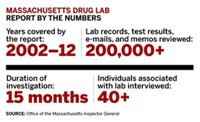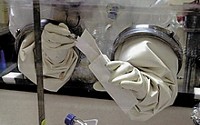Advertisement
Grab your lab coat. Let's get started
Welcome!
Welcome!
Create an account below to get 6 C&EN articles per month, receive newsletters and more - all free.
It seems this is your first time logging in online. Please enter the following information to continue.
As an ACS member you automatically get access to this site. All we need is few more details to create your reading experience.
Not you? Sign in with a different account.
Not you? Sign in with a different account.
ERROR 1
ERROR 1
ERROR 2
ERROR 2
ERROR 2
ERROR 2
ERROR 2
Password and Confirm password must match.
If you have an ACS member number, please enter it here so we can link this account to your membership. (optional)
ERROR 2
ACS values your privacy. By submitting your information, you are gaining access to C&EN and subscribing to our weekly newsletter. We use the information you provide to make your reading experience better, and we will never sell your data to third party members.
Policy
FBI's Anthrax Analysis
Experts discuss experimental techniques used to identify suspect Ivins
by Rochelle Bohaty
August 25, 2008
| A version of this story appeared in
Volume 86, Issue 34

FBI OFFICIALS and scientific experts revealed more information about the scientific experiments used to study anthrax spores disseminated in 2001 mailings at a briefing held on Aug 18. The briefing aimed to ease speculation about the bureau's conclusions.
"After nearly seven years of investigation, we have developed a body of powerful evidence that allows us to conclude that we have identified the origin and the perpetrator of the 2001 Bacillus anthracis mailings," said Vahid Majidi of the FBI's Weapons of Mass Destruction Directorate.
Last month, FBI officials identified Bruce E. Ivins, a longtime anthrax investigator at the U.S. Army Medical Research Institute of Infectious Diseases (USAMRIID), based in Fort Detrick, Md., as the primary suspect in the case. Ivins' death on July 29 from an apparent suicide spurred controversy and speculation about the FBI investigation. Although the FBI does not typically disclose evidence against suspects who have not been officially charged, the circumstances surrounding this case drove the bureau to do so.
At the briefing and in a subsequent interview with C&EN, FBI officials note that in addition to tests used to differentiate strains of anthrax, analytical techniques—such as scanning and transmission electron microscopy (SEM and TEM), energy dispersive X-ray analysis (EDX), and mass spectrometry—provided the bureau with a chemical and elemental profile of the spores used in the attacks.
FBI Laboratory Director Chris Hassell tells C&EN that the data used by the FBI to identify Ivins came from studies conducted by a large number of FBI and non-FBI scientists with varying expertise. This information led FBI officials to conclude that the anthrax in the letters was derived from the Ames strain RMR-1029 that came from one flask at USAMRIID of which Ivins was the sole custodian.
Joseph R. Michael, who works at Sandia National Laboratories and was part of the FBI's scientific briefing, tells C&EN that he analyzed FBI-provided spores from the anthrax-laced letters by SEM, TEM, EDX, and scanning transmission electron microscopy. He says his work uncovered similar characteristics between the anthrax from the laced letters and spores from a library of anthrax spores developed by the FBI.
B. anthracis spores taken by Sandia scientists.

B. anthracis spores taken by Sandia scientists.
According to Michael, his most significant finding was that the spores used in the attack had internalized SiOx rather than having been weaponized by coating with silica. This result gave investigators another characteristic signature of the lethal spores.
"The scientific evidence is compelling," says Rita R. Colwell, former director of the National Science Foundation, which funded some of the research behind the investigation. It is impressive how all the different scientific aspects came together, she says.
As the FBI continues to lay out its scientific evidence, FBI officials have acknowledged several missteps they made during the investigation. They do not believe, however, that the slips compromised the case. For example, the FBI destroyed one of the two original anthrax samples Ivins provided during the initial stages of the investigation because of a problem with the sample preparation protocol. But the FBI later obtained a duplicate sample that had been submitted to an independent lab and analyzed it as part of the investigation.
Hassell says the experimental data need to be validated through a peer review process. He tells C&EN that the FBI has a publication plan, and the process is already under way. Speaking of the science, he adds, "We are hoping to get as much as we can into peer-reviewed journals."




Join the conversation
Contact the reporter
Submit a Letter to the Editor for publication
Engage with us on Twitter